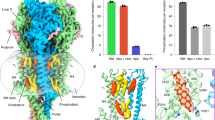Abstract
The acethylcholine receptor was chemically modified using bisulfite to add a sulfonate group to a disulfide bond on the α subunit, and diamide, an oxidizing agent, to form an interchain disulfide bond between β subunits of adjacent receptors. In previous work, both reagents increased mepc decay times but produced no change in mean channel open time or conductance as measured by spectral analysis of endplate current fluctuations (Steinacker and Zuazaga 1981). In the current work, we show that, while both chemical modifications increase the decay time of the miniature endplate current, only sulfonation increases the time to peak. Sulfonation also produced an effect on voltage jump current relaxation time, which parallels the increase in miniature endplate current decay time, and an increase in the ratio of the current relaxation amplitudes. Diamide had no effect on voltage jump current relaxation amplitudes or time constants. These data are analyzed in an attempt to correlate changes in specific rate constants to changes in the macroscopic current measurements.
Similar content being viewed by others
References
Adams DJ (1983) Chemical modification of endplate channels in frog skeletal muscle. J Physiol 343:29–30
Adams PR (1975) Kinetics of agonist conductance changes during hyperpolarization at frog end-plates. Br J Pharmacol 53:308–310
Anderson CR, Stevens CF (1973) Voltage clamp analysis of acetylcholine produced endplate current fluctuations at frog neuromuscular junction. J Physiol 235:655–691
Ascher P, Marty A, Neild TO (1978) Life time and elementary conductance of the channels mediating the excitatory effects of acetylcholine inAplysia neurons. J Physiol 278:177–206
Colquhoun D, Hawkes AG (1977) Relaxation and fluctuations of membrane currents that flow through drug-operated channels. Proc R Soc Lond (Biol) 199:231–262
Colquhoun D, Hawkes AG (1981) On the stochastic properties of single ion channels. Proc R Soc Lond (Biol) 211:205–235
Colquhoun D, Sakmann B (1981) Fluctuations in the microsecond time range of the current through single acetylcholine receptor channels. Nature 294:464–466
Colquhoun D, Sakmann B (1985) Fast events in single-channel currents activated by acetylcholine and its analogues at the frog muscle endplate. J Physiol 369:501–557
del Castillo J, Katz B (1957) Interactions at end-plate receptors between different choline derivatives. Proc R Soc Lond (Biol) 146:369–381
Dionne VE (1981) The kinetics of slow muscle acetylcholine-operated channels in the garter snake. J Physiol 310:159–190
Dionne VE, Stevens CF (1975) Voltage dependence of agonist effectiveness at the frog neuromuscular junction: resolution of a paradox. J Physiol 251:245–270
Dwyer TM (1981) The rising phase of the miniature endplate current at the frog neuromuscular junction. Biochim Biophys Acta 646:51–60
Fiekers JF (1985) Concentration-dependent effects of neostigmine on the endplate acetylcholine receptor channel complex. J Neurosci 5:502–514
Hamilton SL, Mc Laughlin M, Karlin A (1979) Formation of disulfide-linked oligomers of acetylcholine receptor in membranes fromTorpedo electric tissue. Biochemistry 18:155–163
Karlin A (1980) Molecular properties of nicotinic acetylcholine receptors. In: Cotman CW, Poste G, Nicolson GL (eds) “The cell surface and neuronal function”. Elsevier/North-Holland, Amsterdam New York, pp 192–260
Katz B, Miledi R (1972) The statistical nature of the acetylcholine potential and its molecular components. J Physiol 224:665–699
Land BR, Salpeter EE, Salpeter MM (1981) Kinetic parameters for acetylcholine interaction in intact neuromuscular junction. Proc Natl Acad Sci USA 78:7200–7204
Leibowitz MD, Dionne VE (1984) Single-channel acetylcholine receptor kinetics. Biophys J 45:153–163
Lewis CA (1985) Deuterium oxide and temperature effects on the properties of endplate channels at the frog neuromuscular junction. J Gen Physiol 85:137–156
Lukas RJ, Bennett EL (1980) Chemical modification and reactivity of sulfhydryls and disulfides of rat brain nicotinic-like actylcholine receptors. J Biol Chem 255:5573–5577
Madsen BW, Edeson RO, Lam HS, Milne RK (1984) Numerical simulation of miniature endplate currents. Neurosci Lett 48:67–74
Magleby KL, Stevens CF (1972a) The effects of voltage on the time course of endplate currents. J Physiol 223:151–171
Magleby KL, Stevens CF (1972b) A quantitative description of endplate currents. J Physiol 223:173–197
Means GE, Feeney RE (1971) Chemical modification of proteins. Holden-Day, San Francisco, pp 152–154
Neher E, Sakmann B (1975) Voltage-dependence of drug-induced conductance in frog neuromuscular junction. Proc Natl Acad Sci USA 72:2140–2144
Nelson DJ, Sachs F (1979) Properties of single channels in tissue cultured skeletal muscle. Soc Neurosci Abstr 5:487
Ogden DC, Colquhoun D (1983) The efficacy of agonists at the frog neuromuscular junction studied with single channel recording. Pflügers Arch 399:246–248
Sakmann B (1985) Role of acetylcholine receptor subunits in gating of the channel. Nature 318:538–543
Sheridan RE Lester HA (1975) Relaxation measurements on the acetylcholine receptor. Proc Natl Acad Sci USA 72:3496–3500
Steinacker A (1979) Sulphonation of cholinergic receptor disulphide bond increases response to acetylcholine. Nature 278:358–360
Steinacker A, Zuazaga DC (1981) Changes in neuromuscular junction endplate current time constants produced by sulfhydryl reagents. Proc Natl Acad Sci USA 78:7806–7809
Stephenson RP (1956) A modification of receptor theory. Br J Pharmacol 11:379–393
Wathey JC, Nass MM, Lester HA (1979) Numerical reconstruction of the quantal event at nicotinic synapses. Biophys J 27:145–164
Weiland GA, Molinoff PB (1981) Quantitative analysis of drugreceptor interactions: Determination of kinetic equilibrium properties. Life Sci 29:313–330
Young SH, Poo M-M (1983) Topographical rearrangement of acetylcholine receptors alters channel kinetics. Nature 304:161–163
Author information
Authors and Affiliations
Rights and permissions
About this article
Cite this article
Steinacker, A., Zuazaga, C. Further kinetic analysis of the chemically modified acetylcholine receptor. Pflugers Arch. 409, 555–560 (1987). https://doi.org/10.1007/BF00584653
Received:
Accepted:
Issue Date:
DOI: https://doi.org/10.1007/BF00584653




